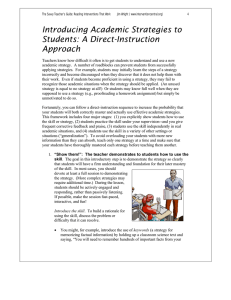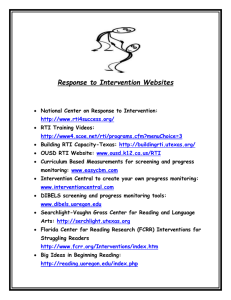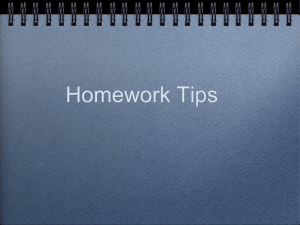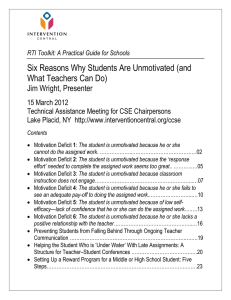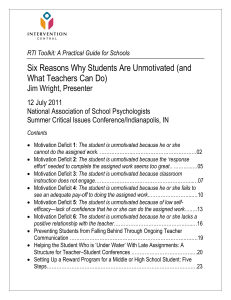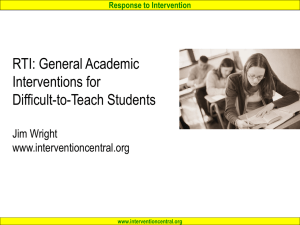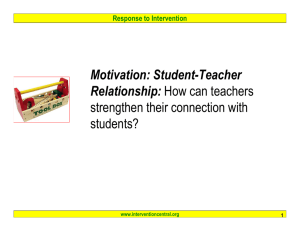Student `Academic Enabler` Skills Checklists
advertisement
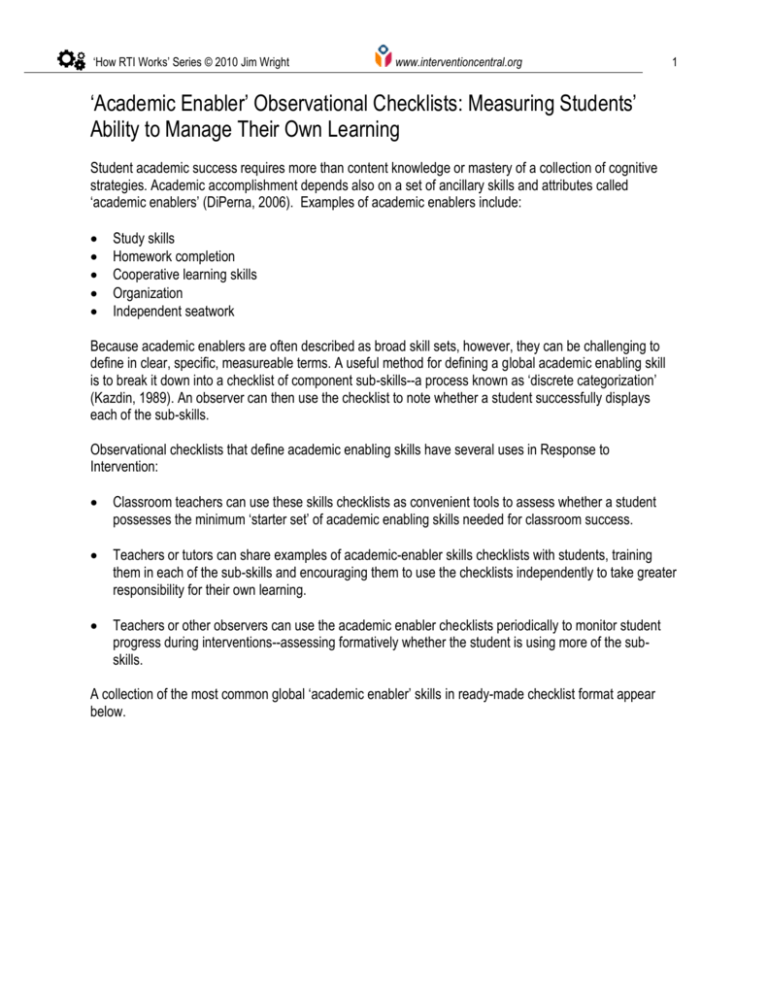
‘How RTI Works’ Series © 2010 Jim Wright www.interventioncentral.org 1 ‘Academic Enabler’ Observational Checklists: Measuring Students’ Ability to Manage Their Own Learning Student academic success requires more than content knowledge or mastery of a collection of cognitive strategies. Academic accomplishment depends also on a set of ancillary skills and attributes called ‘academic enablers’ (DiPerna, 2006). Examples of academic enablers include: Study skills Homework completion Cooperative learning skills Organization Independent seatwork Because academic enablers are often described as broad skill sets, however, they can be challenging to define in clear, specific, measureable terms. A useful method for defining a global academic enabling skill is to break it down into a checklist of component sub-skills--a process known as ‘discrete categorization’ (Kazdin, 1989). An observer can then use the checklist to note whether a student successfully displays each of the sub-skills. Observational checklists that define academic enabling skills have several uses in Response to Intervention: Classroom teachers can use these skills checklists as convenient tools to assess whether a student possesses the minimum ‘starter set’ of academic enabling skills needed for classroom success. Teachers or tutors can share examples of academic-enabler skills checklists with students, training them in each of the sub-skills and encouraging them to use the checklists independently to take greater responsibility for their own learning. Teachers or other observers can use the academic enabler checklists periodically to monitor student progress during interventions--assessing formatively whether the student is using more of the subskills. A collection of the most common global ‘academic enabler’ skills in ready-made checklist format appear below. ‘How RTI Works’ Series © 2010 Jim Wright www.interventioncentral.org Study Skills. The student: takes complete, organized class notes in legible form and maintains them in one accessible note book reviews class notes frequently (e.g., after each class) to ensure understanding When reviewing notes, uses highlighters, margin notes, or other strategies to note questions or areas of confusion for later review with teacher or tutor follows an efficient strategy to study for tests and quizzes allocates enough time to study for tests and quizzes 2 Poor Fair Good 1 2 3 NA Poor Fair Good 1 2 3 NA Poor Fair Good 1 2 3 NA Poor Fair Good 1 2 3 NA Poor Fair Good 1 2 3 NA – – – – – Poor Fair Good NA is willing to seek help from the teacher to answer questions or clear up areas of 1 2 3 – confusion Other: ___________________________________________________________ Comments: ________________________________________________________________________________________________________________________________ ________________________________________________________________________________________________________________________________ Organization Skills. The student: arrives to class on time. Poor Fair Good 1 2 3 NA maintains organization of locker to allow student to efficiently store and retrieve needed books, assignments, work materials, and personal belongings maintains organization of backpack or book bag to allow student to efficiently store and retrieve needed books, assignments, work materials, and personal belongings brings to class the necessary work materials expected for the course (e.g., pen, paper, calculator, etc.) is efficient in switching work materials when transitioning from one in-class learning activity to another Poor Fair Good 1 2 3 NA Poor Fair Good 1 2 3 NA Poor Fair Good 1 2 3 NA Poor Fair Good 1 2 3 NA Other: ___________________________________________________________ Poor Fair Good 1 2 3 NA – – – – – – Comments: ________________________________________________________________________________________________________________________________ ________________________________________________________________________________________________________________________________ ‘How RTI Works’ Series © 2010 Jim Wright www.interventioncentral.org Homework Completion. The student: writes down homework assignments accurately and completely makes use of available time in school (e.g., study halls, homeroom) to work on homework has an organized, non-distracting workspace available at home to do homework creates a work plan before starting homework (e.g., sequencing the order in which assignments are to be completed; selecting the most challenging assignment to start first when energy and concentration are highest) when completing homework, uses highlighters, margin notes, or other strategies to note questions or areas of confusion for later review with teacher or tutor turns in homework on time Other: ___________________________________________________________ 3 Poor Fair Good 1 2 3 NA Poor Fair Good 1 2 3 NA Poor Fair Good 1 2 3 NA Poor Fair Good 1 2 3 NA Poor Fair Good 1 2 3 NA Poor Fair Good 1 2 3 NA Poor Fair Good 1 2 3 NA – – – – – – – Comments: ________________________________________________________________________________________________________________________________ ________________________________________________________________________________________________________________________________ Cooperative Learning Skills. The student: participates in class discussion gets along with others during group/pair activities participates fully in group/pair activities does his or her ‘fair share’ of work during group/pair activities is willing to take a leadership position during group/pair activities Other: ___________________________________________________________ Poor Fair Good 1 2 3 NA Poor Fair Good 1 2 3 NA – – Poor Fair Good NA 1 2 3 – Poor Fair Good NA 1 2 3 – Poor Fair Good 1 2 3 NA Poor Fair Good 1 2 3 NA – – Comments: ________________________________________________________________________________________________________________________________ ________________________________________________________________________________________________________________________________ ‘How RTI Works’ Series © 2010 Jim Wright www.interventioncentral.org Independent Seat Work. The student: has necessary work materials for the assignment is on-task during the assignment at a level typical for students in the class refrains from distracting behaviors (e.g., talking with peers without permission, pen tapping, vocalizations such as loud sighs or mumbling, etc.) recognizes when he or she needs teacher assistance and is willing to that assistance requests teacher assistance in an appropriate manner 4 Poor Fair Good 1 2 3 NA Poor Fair Good 1 2 3 NA – – Poor Fair Good NA 1 2 3 – Poor Fair Good NA 1 2 3 – Poor Fair Good 1 2 3 NA requests assistance from the teacher only when really needed Poor Fair Good 1 2 3 NA if finished with the independent assignment before time expires, uses remaining time to check work or engage in other academic activity allowed by teacher takes care in completing work—as evidenced by the quality of the finished assignment is reliable in turning in assignments done in class. Poor Fair Good 1 2 3 NA Poor Fair Good 1 2 3 NA Poor Fair Good 1 2 3 NA Poor Fair Good 1 2 3 NA Other: ___________________________________________________________ Comments: – – – – – – ________________________________________________________________________________________________________________________________ ________________________________________________________________________________________________________________________________ Motivation. The student: has a positive sense of ‘self-efficacy’ about the academic content area (selfefficacy can be defined as the confidence that one can be successful in the academic discipline or subject matter if one puts forth reasonable effort) displays some apparent intrinsic motivation to engage in course work (e.g., is motivated by topics and subject matter discussed or covered in the course; finds the act of working on course assignments to be reinforcing in its own right) displays apparent extrinsic motivation to engage in course work (e.g., is motivated by grades, praise, public recognition of achievement, access to privileges such as sports eligibility, or other rewarding outcomes) Other: ___________________________________________________________ Poor Fair Good 1 2 3 NA Poor Fair Good 1 2 3 NA Poor Fair Good 1 2 3 NA Poor Fair Good 1 2 3 NA – – – – Comments: ________________________________________________________________________________________________________________________________ ________________________________________________________________________________________________________________________________ ‘How RTI Works’ Series © 2010 Jim Wright www.interventioncentral.org 5 Teacher-Defined Academic Enabling Skill: Skill Name: ___________________________________________________________________________ Essential Subskills: The student:: ________________________________________________________________ Poor Fair Good NA 1 2 3 – ________________________________________________________________ ________________________________________________________________ ________________________________________________________________ Poor Fair Good NA 1 2 3 – ________________________________________________________________ ________________________________________________________________ ________________________________________________________________ Poor Fair Good NA 1 2 3 – ________________________________________________________________ ________________________________________________________________ ________________________________________________________________ ________________________________________________________________ Poor Fair Good 1 2 3 NA Poor Fair Good 1 2 3 NA ________________________________________________________________ ________________________________________________________________ ________________________________________________________________ ________________________________________________________________ Comments: ________________________________________________________________________________________________________________________________ ________________________________________________________________________________________________________________________________ References DiPerna, J. C. (2006). Academic enablers and student achievement: Implications for assessment and intervention services in the schools. Psychology in the Schools, 43, 7-17. Kazdin, A. E. (1989). Behavior modification in applied settings (4th ed.). Pacific Gove, CA: Brooks/Cole.
